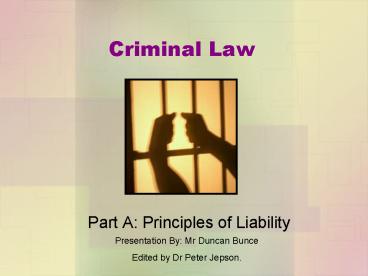Criminal Law - PowerPoint PPT Presentation
1 / 16
Title:
Criminal Law
Description:
You should have read and pr cised Part A of the booklet or read chapter 11 of ... Case: Winzar v Chief Constable of Kent (1983) D found drunk in hospital, ... – PowerPoint PPT presentation
Number of Views:260
Avg rating:3.0/5.0
Title: Criminal Law
1
Criminal Law
- Part A Principles of Liability
Presentation By Mr Duncan Bunce Edited by Dr
Peter Jepson.
2
Requirements
- Turn off your mobile phone
- You should have read and précised Part A of the
booklet or read chapter 11 of GCSE Law by
Jacqueline Martin - Take notes (annotate your pdf slides)
- Please raise your hand if you have a question.
3
Criminal Law
- In a criminal case, the prosecution must
establish beyond reasonable doubt that D is
responsible for the crime - Why is the State prosecuting and not the
victim? - Is the D innocent before proven guilty?
- Case Woolmington v DPP (1935)
4
Elements of a Crime
- Generally, for a criminal offence to exist
two elements must be present - (1) Actus reus (guilty act)
- (2) Mens rea (guilty mind)
- The prosecution must prove these two elements
exist if the D is to be found guilty.
5
Each offence has its own actus reus/mens rea
- For example
- Daniel returns home from work to discover his
wife with another man. Furious, Daniel goes to
the kitchen to get a knife. He stabs the man,
killing him. - What offence has been committed?
- What is the actus reus?
- What is the mens rea?
6
The Actus Reus
- The physical element of the crime
- A prohibited voluntary act
- A failure to act (an omission)
- Case 1 Stone Dobinson (1977) Ds guilty
of neglecting V, who died in their care. - Case 2 Miller (1983) D guilty of arson
when he failed to put out a fire which came from
his lit cigarette.
7
The Actus Reus Cont.
- A state of affairs
- Case Winzar v Chief Constable of Kent (1983)
D found drunk in hospital, removed to public
highway by police and charged with being found
drunk in the highway. - Note Ds act need not simply be voluntary to
satisfy the actus reus!
8
The Theory of Causation
- The act must cause the result.
- Causation is like a chain Ds actions should be
a direct link (i.e. the cause) of the result.
E.g. If Jack pushes Jill down a hill and she
dies, Jack is the direct cause.
9
The Theory of Causation Cont.
- An intervening act will break the chain of
causation. - E.g. If Jack pushes Jill down the hill and
she then rolls onto a main road and is squished
by a lorry. - Is Jack guilty of an offence?
10
The Theory of Causation Cont.
- Rules of causation
- Ds action must be a factual cause of death
Case R v White (1910) D tried to poison his
mother but she unexpectedly died of natural
causes before he could give it to her.
But For Test but for Ds actions would the
victim have died?
11
The Theory of Causation Cont.
- (2) Ds actions need not be the sole cause of
death - Case R v Pagett (1983) D used his pregnant
girlfriend as a human shield in hostage
situation. Girlfriend died in police gunfire. - Note Ds actions need only be a substantial
cause of death.
12
The Theory of Causation Cont.
- (4) Must take your victim how you find them
(or Thin Skull Rule) - D cannot be excused simply because s/he
didnt know V was more susceptible to serious
injury/death. - What happened in R v Blaue (1975)?
- Should the D have been found guilty?
13
The Theory of Causation Cont.
- (5) Medical intervention kills the V, D may still
be liable - Case One R v Smith (1959) an operating
and substantial cause of death
Case Two R v Cheshire (1991) - Ds acts need not
be the sole or even the main cause of
death. Case Three R v Jordan (1956) - palpably
wrong medical treatment
14
Mens Rea
- Two basic categories
- Intention
- Where the D desires the outcome and sets out to
ensure it occurs (direct) or - Where the D does not desire the outcome but
recognizes that death or serious harm is a
virtual certainty (Indirect - see R v Woollin
1998).
15
Mens Rea
- (2) Recklessness
- There is now only one test for recklessness
(subjective). - Did the D foresee there was a risk involved?
- R v G and R (2003) the Ds, aged 11 and 12,
set fire to a wheelie bin. Fire spread causing
damage to the neighbouring building. Ds did not
appreciate the risk found not guilty (follows R
v Cunningham).
16
Strict Liability Offences
- The D only needs to commit the actus reus to be
found guilty of the crime. - The Ds state of mind at the time is irrelevant.
- Why do you think we have strict liability
offences? Is it unfair on the D who is committing
a crime but may not realise it? - Meah v Roberts (1977) two children who
asked for lemonade were served with caustic soda.
D found guilty of selling food unfit for human
consumption.































